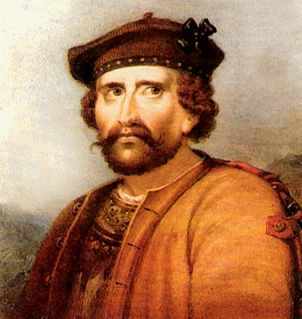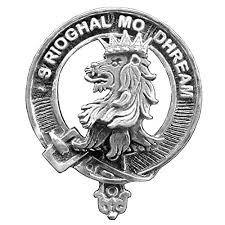The Story of Rob Roy MacGregor
|
|
|
|
Rob Roy MacGregor was born in 1671, the second son of Donald Glas MacGregor of Glengyle and Margaret Campbell of the Glenfalloch Campbells. The family lived at the Steadings near Portnellan, at the north end of Loch Katrine, where Rob grew up, married, and learned the cattle trade. His life can be divided into three parts – the years at Loch Katrine, his “outlaw period”, romanticized by Sir Walter Scott in his novel Rob Roy, and the last third of his life at Inverlochlarig in Balquhidder glen where he was buried in 1734.
Along with many Highland clansmen, at the age of eighteen and together with his father, Rob joined the Jacobite rising of 1689 led by John Graham, 1st Viscount Dundee, known as “Bonnie Dundee”, in support for the Stuart King James II who had fled Britain following the Glorious Revolution of 1688. The Rising is marked by the famous battle at Killiecrankie, a stunning Jacobite victory which sadly saw Dundee was killed in the initial charge. Leaderless, and facing a daunting winter, the rebellion ended in a bloody street fight at Dunkeld where both sides suffered greatly, although James’ cause was lost in Scotland. As retribution, Donald Glas and Rob’s older brother John were thrown in the tolbooth, Edinburgh’s notorious prison, where they were held on treason charges for two years. John would die in 1692 largely as a result of his treatment in the tolbooth. Donald Glas too never regains his health and is buried by Rob at Portnellan in 1702.
This left Rob in charge at home, where he married Mary MacGregor of Comar. Their first son, James Mhor (“Big James”) was born in 1695. They had three more sons, at least one daughter, adopted Duncan, a cousin, and took on responsibility for John’s family as well.
Rob Roy became a respected cattleman – a demanding trade which required a loyalty where a man’s word was his bond. It was also a time when cattle rustling and protection against theft were commonplace means of earning a living. He moved to Inversnaid village near Loch Lomond and is known to have run herds down to the famous marketplace at Crieff, even taking cows down into England on occasion. All was looking up until 1712, when Rob Roy, having borrowed a large sum from a number of creditors, among them the Duke of Montrose, fell on hard times. Owing to the disappearance of his chief drover, who was entrusted with a large sum to bring cattle back from the Isles, Rob Roy was blamed despite his best efforts to find the drover – who was never seen again in Scotland. Solely on his word, as was the accepted custom in those times, Rob was able to come to terms with all twenty-six of his creditors - all except one – James Graham, 4th Duke of Montrose who desperately (and foolishly) attempted to use the event to push Rob and the Glengyle MacGregors out of his lands. Invoking his rank and privilege on the Privy Council, Graham had Rob Roy declared an outlaw. His wife and family were forcefully evicted from their house at Inversnaid, which was then burned. His possessions and cattle were seized. The result was that Rob Roy declared a private war against the Duke, which began the stories of his famous exploits as an outlaw and a folk hero – the so-called “Robin Hood” era – which has some truth to it! The private war with Montrose went on for nearly ten years. During this time Rob found support from his mother’s family, notable John Campbell, Duke of Argyll. No friend of Grahams’, the Campbells could offer Rob shelter in their lands, where no long arm of Graham’s (who was using British redcoats to pursue the outlaw by this time) could reach him. By 1722, Rob Roy has become a master at playing one duke against another, and Graham’s power at court begins to wane. But even greater changes were about to happen.
Rob Roy in Popular Culture
The year 1723 saw the publication of a fictionalized account of his life, The Highland Rogue by none other than Daniel Defoe of Robinson Crusoe fame. Rob Roy became something of a legend in his own lifetime, and upon reading the book, King George I was moved to suspend the order for Rob to be transported to the colonies, which was imminent. This was not simply by the wave of a magic wand but the result of political engineering at court by John Campbell, the Duke of Argyll whose star was rising. By making his submission to the Crown, aided by Argyll, Rob Roy was granted a commission for the Highland Watch, a company of men to guarantee the return of stolen cattle to their owners in the highlands. It is said that the pattern for the Black Watch, formed in 1742, was based in part on Rob’s success. Thus, marks the third remarkable phase of Rob Roy MacGregor’s life. But the story doesn’t end here.
In 1734, a quarrel arises in Balquhidder glen between the MacLarens and the MacGregors over land ownership. Both sides make ready for a fight, said to take place in a field just below the churchyard. Rob steps forward and offers a challenge of single combat to avoid bloodshed. The MacLarens put up Alasdair Stewart of Invernahyle, said to be the best swordsman in Scotland at the time. Rob is 63 years old.
The duel ensues until Rob receives a cut across his arm. Stewart gallantly declares the honor of both sides is served, having no desire to harm a man with 24 personal duels to his credit, and the clans disband. Rob returns to his house at Inverlochlarig Beg, and dies peacefully in his own bed six months later - Dec 1734. There’s a story that he first calls for a priest who he then sends away, then calls for his piper instead, asking him to play Ha til me tulidh – “we return no more”. Rob is dead before the song ends.
The publication of Rob Roy, by Sir Walter Scott in 1817, further added to his fame, both fleshing out the biography and adding to the myth. It became a massive best seller across Europe, and is touted by tour guides at Scott’s home as “the book that built Abbotsford” Hector Berlioz was inspired by the book to compose an overture. William Wordsworth wrote a poem called "Rob Roy's Grave" during a visit to Scotland. The 1803 tour was documented by his sister Dorothy in Recollections of a Tour Made in Scotland. The editor of the book changed the place of burial to the present location.
Adaptations of his story have also been told in film, including the silent film Rob Roy(1922), the Walt Disney Productions film Rob Roy, the Highland Rogue(1953), and the Rob Roy(1995) film directed by Michael Caton-Jones, starring actor Liam Neeson as the title character, and shot entirely on location in the Scottish Highlands.
In 1894, a bartender at the Waldorf Hotel in New York City created the Rob Roy cocktail in honor of the premiere of Rob Roy, an operetta by composer Reginald De Koven and lyricist Harry B. Smith loosely based upon Robert Roy MacGregor.
In 2017, a new statue of Rob Roy was commissioned to be installed in Peterculter, Aberdeen, Scotland. The sculptor appointed was David J. Mitchell, a graduate of Grays School of Art in Aberdeen.
*Note – For more in-depth information about Rob Roy and his times, don’t miss the Clan Gregor Society newsletter #88 which comes with your membership in the Society.
Search our entire Clan Gregor GLC web site:Clan Gregor Society |
| Address: Joseph Greer, GLC Chair 118 Braybarton Blvd. Steubenville OH 43952-1123 740.275.4025 |
 Burial at Balquhidder Kirk
Burial at Balquhidder Kirk Rob Roy Portrait
Rob Roy Portrait Rob Roy Tartan Ancient
Rob Roy Tartan Ancient